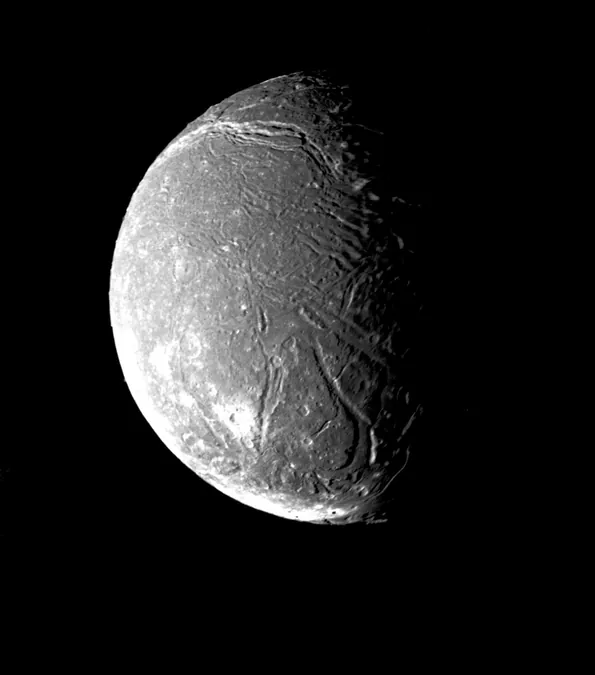
Are Uranus's Mysterious Moons Hiding Liquid Oceans? New Research Could Uncover Their Secrets!
2024-11-25
Author: Rajesh
Introduction
NASA's Voyager 2 captured mesmerizing images of Uranus and its large ice-covered moons back in 1986. Almost four decades later, the space agency is gearing up to launch a new mission towards the icy planet, this time with advanced technology designed to probe whether these frigid moons conceal hidden oceans of liquid water beneath their icy exteriors.
Innovative Research
As researchers from the University of Texas Institute for Geophysics (UTIG) meticulously prepare for this groundbreaking expedition, they’ve developed an innovative computer model that aims to detect these elusive oceans using only the spacecraft's cameras.
Significance of the Research
The significance of this research is monumental. Scientists are aware that liquid water is a vital component for life, and understanding the composition of Uranus's moons could revolutionize our perception of where life may exist beyond our planet. The newly developed model operates by examining the oscillations—or wobbles—of a moon's spin as it orbits Uranus. These wobbles can indicate the internal structure of the moon: minimal wobble suggests a solid composition, while substantial wobble hints at an icy layer floating over a liquid ocean. Combining this information with gravity data could yield insights into the thickness of the ice and the depth of any hidden oceans.
Broader Implications
Uranus, classified as an ice giant alongside Neptune, is intriguing not only for its own moons, but for the broader implications its findings could hold. In recent years, astronomers have identified a multitude of ice giant-sized exoplanets outside our solar system. If evidence of liquid water oceans is uncovered within Uranus's moons, it could suggest that countless potential habitable worlds exist throughout our galaxy. Doug Hemingway, a UTIG planetary scientist instrumental in the model's development, asserts, "Discovering liquid water oceans inside the moons of Uranus would transform our thinking about the range of possibilities for where life could exist."
Understanding Oscillations
All large moons within our solar system, including those orbiting Uranus, are tidally locked. This phenomenon means that one hemisphere always faces the planet they orbit. However, despite being tidally locked, these moons still exhibit slight wobbles as they travel. Understanding the degree of these oscillations is critical for determining whether these moons harbor oceans and how expansive they may be.
Wobbles and Oceans
Interestingly, even the most expansive of oceans could induce only minor wobbles—sometimes just a few hundred feet—in the moon's rotation. Remarkably, this slight movement can still be detectable by spacecraft. This technique has previously confirmed the presence of a vast ocean beneath Saturn's moon Enceladus.
Theoretical Calculations
Hemingway has conducted theoretical calculations for five of Uranus’s moons, establishing various plausible scenarios regarding their internal compositions. For instance, if Ariel, one of Uranus's moons, wobbles by 300 feet, it could indicate an ocean around 100 miles deep, encased by a 20-mile-thick layer of ice.
Future Missions
Detecting smaller oceans may require spacecraft to venture closer or utilize more powerful cameras. However, this new model serves as a critical compass for mission designers, enabling them to gauge strategies that could be key to discovering whether oceans exist. Krista Soderlund, a UTIG Research Associate Professor, emphasizes the model's importance, stating, "It could be the difference between discovering an ocean or finding we don't have that capability when we arrive."
Conclusion
The next phase of research involves integrating data from additional instruments to further illuminate the secrets shrouded within these enigmatic moons. As we stand on the brink of new discoveries, the questions about life beyond Earth remain tantalizingly unanswered. Will we uncover the mysteries hidden beneath the icy shells of Uranus’s moons? The universe is watching, and the next chapter of exploration is about to unfold!




 Brasil (PT)
Brasil (PT)
 Canada (EN)
Canada (EN)
 Chile (ES)
Chile (ES)
 España (ES)
España (ES)
 France (FR)
France (FR)
 Hong Kong (EN)
Hong Kong (EN)
 Italia (IT)
Italia (IT)
 日本 (JA)
日本 (JA)
 Magyarország (HU)
Magyarország (HU)
 Norge (NO)
Norge (NO)
 Polska (PL)
Polska (PL)
 Schweiz (DE)
Schweiz (DE)
 Singapore (EN)
Singapore (EN)
 Sverige (SV)
Sverige (SV)
 Suomi (FI)
Suomi (FI)
 Türkiye (TR)
Türkiye (TR)